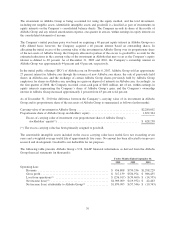Yahoo 2010 Annual Report Download - page 69
Download and view the complete annual report
Please find page 69 of the 2010 Yahoo annual report below. You can navigate through the pages in the report by either clicking on the pages listed below, or by using the keyword search tool below to find specific information within the annual report.Current deferred revenue is comprised of contractual billings in excess of recognized revenue and payments
received in advance of revenue recognition. Long-term deferred revenue includes amounts received from
customers for which services will not be delivered within the next 12 months.
Restructuring Charges. The Company has developed and implemented restructuring initiatives to improve
efficiencies across the organization, reduce operating expenses, and better align its resources to market
conditions. As a result of these plans, the Company has recorded restructuring charges comprised principally of
employee severance and associated termination costs related to the reduction of its workforce, office closures,
losses on subleases, and contract termination costs. Liabilities for costs associated with an exit or disposal
activity are recognized when the liability is incurred, as opposed to when management commits to an exit plan.
In addition, (i) liabilities associated with exit and disposal activities are measured at fair value; (ii) one-time
termination benefits are expensed at the date the entity notifies the employee, unless the employee must provide
future service, in which case the benefits are expensed ratably over the future service period; and (iii) costs to
terminate a contract before the end of its term are recognized when the entity terminates the contract in
accordance with the contract terms. In addition, a portion of the Company’s restructuring costs related to
international employees whose termination benefits are recognized when the amount of such termination benefits
becomes estimable and payment is probable.
These restructuring initiatives require management to make estimates in several areas including: (i) realizable
values of assets made redundant, obsolete, or excessive; (ii) expenses for severance and other employee
separation costs; and (iii) the ability to generate sublease income and to terminate lease obligations at the
estimated amounts.
Allowance for Doubtful Accounts. The Company records its allowance for doubtful accounts based upon its
assessment of various factors. The Company considers historical experience, the age of the accounts receivable
balances, the credit quality of its customers, current economic conditions, and other factors that may affect
customers’ ability to pay to determine the level of allowance required.
TAC. TAC consists of payments made to third-party entities that have integrated the Company’s advertising
offerings into their Websites or other offerings and payments made to companies that direct consumer and
business traffic to Yahoo! Properties. The Company enters into agreements of varying duration that involve
TAC. There are generally two economic structures of the Affiliate agreements: fixed payments based on a
guaranteed minimum amount of traffic delivered, which often carry reciprocal performance guarantees from the
Affiliate or variable payments based on a percentage of the Company’s revenue or based on a certain metric,
such as the number of searches or paid clicks. The Company expenses, as cost of revenue, TAC under two
different methods. Agreements with fixed payments are expensed ratably over the term the fixed payment covers.
Agreements based on a percentage of revenue, number of searches, or other metrics are expensed based on the
volume of the underlying activity or revenue multiplied by the agreed-upon price or rate.
Product Development. Product development expenses consist primarily of compensation related expenses
(including stock-based compensation expense) incurred for research and development, the development of,
enhancements to, and maintenance and operation of Yahoo! Properties, advertising products, technology
platforms, and infrastructure. Depreciation expense, third-party technology and development expense, and other
operating costs are also included in product development.
Advertising Costs. Advertising production costs are recorded as expense the first time an advertisement appears.
Costs of communicating advertising are recorded as expense as advertising space or airtime is used. All other
advertising costs are expensed as incurred. Advertising expense totaled approximately $190 million, $197
million, and $237 million for 2008, 2009, and 2010, respectively.
Stock-Based Compensation Expense. The Company recognizes stock-based compensation expense net of an
estimated forfeiture rate and therefore only recognizes compensation costs for those shares expected to vest over
67
























